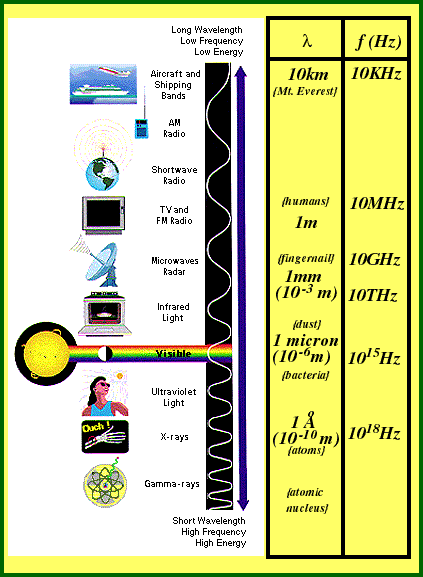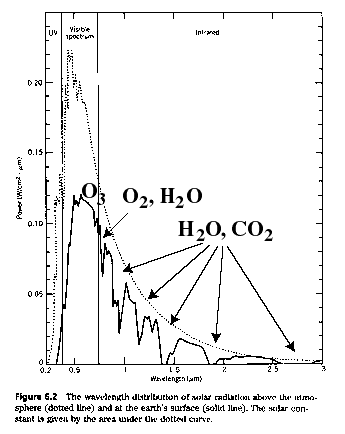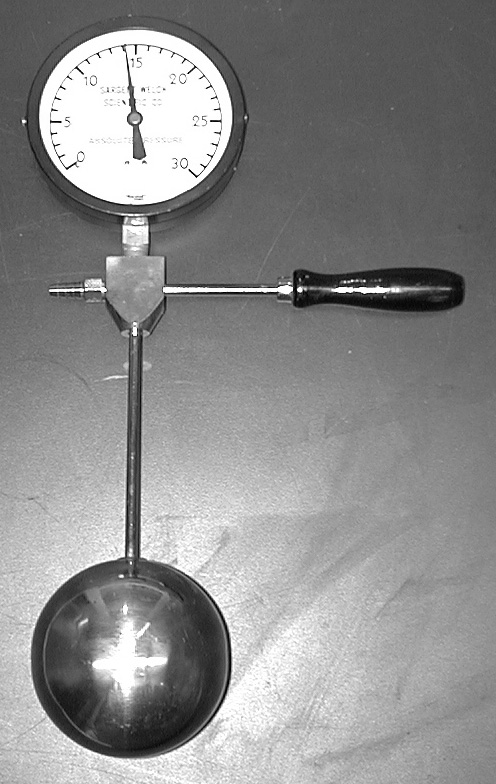Remember looking at those funky filmstrips of water ripples in a wave tank?

{adopted from Imagine! the Universe Home Page}
We can devise a simple tool that allows us to examine the spectrum (range of frequencies) of a light bulb at a certain temperature, T1. With this tool we could measure the intensity (brightness) of each color of light (visible and invisible) emitted from the bulb.
Physicists call something that emits and absorbs radiation in an ideal way a "blackbody." Any EM radiation emitted or absorbed by a blackbody will depend only on its temperature.
If we undertake the same experiment for a similar blackbody emitter, but one with a greater temperature, we see that the wavelength of the highest intensity decreases (which is the same as saying that the frequency increases). Also, and importantly, the bandwidth-- the span of covered wavelengths-- increases.
Using our "spectral analyzer" (above), I could plot the spectrum of the Sun. Assuming that the Sun is a blackbody, I could then estimate its temperature. Experiments show that the total radiated power (P) over all wavelengths for a blackbody is related to its temperature by:
P = s A T4 {Watts}
where "s" is a universal constant (5.67 x 10-8 W/m2 K4), "A" is the area of the radiating surface (of the Sun in this case) and "T" is the temperature in Kelvin.
Why is this important?
Well, the sun emits radiation (mostly infrared+light+ultraviolet) as if it were a black body at 5900 Kelvins (K). Compared to the approximately 300 K Earth, it emits over a broader bandwidth and with a higher peak frequency (in the visible, which is why our eyes developed to see it).

(source: Energy & Problems of a Tech. Society- Kraushaar & Ristenen, absorption lines adopted from Piexoto & Oort, Physics of Climate)
The Earth is so cool as to not emit visible light. It radiates over a spectrum that is much narrower and shifted to longer wavelengths (lower frequencies). CO2 and other "greenhouse gases" absorb certain of the lower frequencies and heat up. They re-radiate this heat into the Earth's atmosphere and reflect some of it back towards the Earth. Because of this phenomenon, the Earth is inhabitable, without it the Earth would be quite cold! Of course, too much CO2 can be thought of as too much of a good thing.....
After a cold day out skiing, we head inside to sit next to a fire and "heat up." But what exactly do we mean by this? Also, when we burn gasoline to provide energy for our car, or we drop water through a turbine at a hydroelectric power plant, we inevitably lose energy to "heat." Again, what do we mean by heat?
When we listen to the weather forecast, a key piece of information is the prediction of what temperature it will be tomorrow. We know that a warm temperature, say 60 degrees Farenheit, means that we can wear a lighter coat. If it is expected to be cold, we wear a heavier coat, i.e. one that insulates us better from the cold. An object's temperature is related to the "hotness" of the body.
Thermometers tell us what the temperature of an object is. This reading tells us, evidently, something about heat. Temperature is typically measured in degrees Celsius, where a temperature of 0 C is where water freezes and 100 C is where water boils (when the US catches up with the entire rest of the world, we will come to understand temperatures in degrees Celsius, not degrees Farenheit, where water freezes at 32 F and boils at 212 F).
But what is temperature? Let's do an experiment via a computer simulation. Consider that you have a gas, represented by balls in a balloon. The temperature of the gas inside the balloon is adjustable. What properties of these balls will we observe that tells us about their temperature?
What happens when a piece of hot metal, one with a high temperature is placed in a colder environment? Say, for example, that a red hot piece of metal is dropped in room temperature water. Over time the metal will cool and the water will heat up. Eventually the two objects will have the same temperature. They are then said to be in thermal equilibrium with one another.
During the intervening time the hot metal is transfering energy to the water. How can we tell? The water can do more work than it could before. The water might boil, for example. A piston could be placed over the water in a sealed container, and the piston would lift, much like the lid rattling on a pot of boiling water. The piston would gain gravitation potential energy in lifting, so work had to be done on it. The original energy came from the hot piece of metal.
So energy is transferred from the hot metal, eventually, to the piston. Evidently heat involves some sort of energy transfer. And a temperature difference is necessary for that energy transfer to take place. {That is, unless we could lift the piston somehow by putting a piece of room temperature metal into room temperature water (NOT likely)}.
To get a better understanding of temperature and heat energy, consider a box full of gas atoms or molecules at some temperature, T. If we built our box with transparent sides and could somehow see the molecules or atoms inside, what would they be doing? What if we marked just one molecule so that we could see it, and restrained its motion to two dimensions?
Here are some questions to ask yourself when watching this movie:
You will remember that the temperatures given above for black bodies were listed in "Kelvins." What is a Kelvin? Why do we use it?
It turns out that there is a temperature--absolute zero-- where particles in a system have no kinetic energy (they don't move). The temperature of such a system is 0 Kelvins. So Kelvins are units of temperature which reference absolute zero.
We can estimate absolute zero with a simple demonstration, predicated on the proportional relationship between temperature and pressure for an ideal gas at constant volume.

We spoke of transfering heat energy to water from a piece of hot metal. Typically the water, in turn, loses its newly-gained thermal energy to its surroundings. The whole process takes time.
What if we do work on a gas and don't give it time to lose heat energy to its surroundings. What happens to the gas?
We can simulate what happens to the gas molecules during adiabatic (no heat transfer) compression by using the following QuickTime movie:
When we do work (W) on the system, we increase its internal energy (DU, following the notation of our textbook), as evinced by an increase in temperature. We can codify this finding as a simple equation:
DU = W
This says that doing work on a system changes its internal energy by an amount equal to the work. (what happens if work is done by the system?)
We can do a demo that shows this increase in internal energy very dramatically:
Suppose I took a syringe full of air but with a little bit of paper at the bottom. Suppose I rapidly pushed down on the plunger? What would happen? How is this process represented by the first law of thermodynamics? What can we say about the internal energy of the air in the syringe? What can we say about heat energy transfer?

Now what if I very slowly pushed down on the plunger? Would the paper ignite? Why or why not?
Pushing down slowly gives the system (gas in the tube) time to cool down, via heat energy transfer to its surroundings. So, evidently, transfering heat energy (-DQ) to its surroundings decreases internal energy. {If we define DQ to be heat transfered to the system, then -DQ is heat energy transferred from the system.} We can summarize this as follows:

This is just a statement of energy conservation in disguise. In fact, this is the most general statement of energy conservation one can make. The (internal) energy of a closed system changes by transferring heat energy in (DQ is positive) or out of it and by doing work on it (W is positive) or having it do work on its surroundings.
IMPORTANT NOTE: A system refers to group of objects and the boundary around them. The internal energy, DU, is a measure of the state of a system. It, like temperature and pressure, are state variables. They all tell you about the "guts" of a system. Heat energy transfer, DQ, and work, W, are done either on or by systems. They involve energy transfer between a system and its surroundings, across the system boundary. One does not speak of the "work of a system" or the "heat energy of a system."